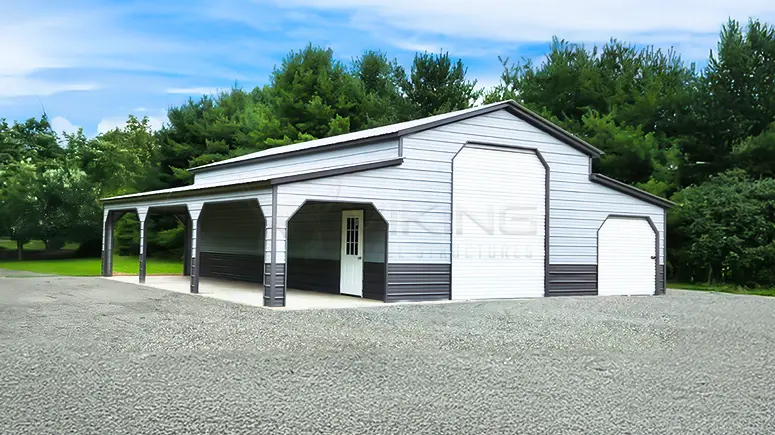How To Prepare a Metal Building Installation Site?

Investing in a metal building is a smart move. Whether it’s for a carport, garage, barn, or commercial space, metal buildings are durable, cost-effective, and easy to maintain. But before you can start enjoying the benefits of your new structure, there’s a crucial step you can’t overlook; that is preparing the installation site.
Proper site preparation sets the foundation—literally and figuratively—for the stability, longevity, and overall success of your metal building. In this comprehensive guide, we’ll walk you through everything you need to know about preparing your metal building site, from assessing the land to final grading.
1. Evaluate and Select the Site
The first step in preparing for your metal building installation is choosing the right location and evaluating its suitability. A well-thought-out site selection can prevent a host of future problems.
Key Factors to Consider:
- Level Ground: The site should be as level as possible. If the area has slopes or uneven terrain, you may need to consider grading to create a flat surface.
- Drainage: Ensure that the site has proper drainage to prevent water from pooling around the base of your building. Poor drainage can cause foundation damage over time.
- Accessibility: Consider how easily construction crews and vehicles can access the site. You’ll also want to think about how you’ll use the building and whether the location provides easy access for future use.
- Surroundings: Make sure there are no obstacles like trees, power lines, or underground utilities that could interfere with the installation process or the building's structure.
Tip: It’s a good idea to consult with a professional or a site engineer if you’re unsure about the best location.
2. Clear and Excavate the Land
Once you’ve selected the ideal site, the next step is to clear the area of any obstacles. This involves removing vegetation, debris, and any structures or objects that may be in the way.
Clearing the Land:
- Remove Vegetation: This includes grass, shrubs, trees, and roots. Clearing these elements helps prevent plant growth from disrupting your foundation in the future.
- Eliminate Debris: Rocks, stumps, old concrete, or other debris should be removed to create a smooth, workable surface.
- Excavation: Depending on the slope and soil conditions, you might need to excavate part of the site to make it level. This is especially important if the site has significant elevation changes.
Equipment Needed: A backhoe, bulldozer, or excavator may be necessary for larger projects. For smaller sites, hand tools and smaller machinery may suffice.
3. Conduct Soil Testing
Soil testing is a critical, but often overlooked, step in site preparation. The type and stability of the soil can greatly impact the performance and durability of your metal building.
Why Soil Testing Matters:
- Soil Bearing Capacity: This measures how much weight the soil can support. If the soil has a low bearing capacity, you may need to take additional measures, like adding gravel or compacting the soil, to ensure a stable foundation.
- Drainage Properties: Soil with high clay content, for example, doesn’t drain well and can cause water pooling around your foundation. Soil tests can guide you on whether drainage improvements are necessary.
- Compaction: Loose or unstable soil needs to be compacted to create a solid base. Soil compaction equipment, like a plate compactor or roller, can be used for this purpose.
4. Plan for Drainage
Proper drainage is essential to protect your metal building from water damage. Without effective drainage, water can accumulate around the base, leading to rust, erosion, and foundation issues.
Drainage Solutions:
- Grading the Land: Slope the ground away from the building site so that water flows away from the structure. A slope of at least 5% is generally recommended.
- French Drains: Install French drains if your site has a high water table or poor drainage. These underground drainage systems help direct water away from your foundation.
- Gravel Beds: Adding a layer of gravel around the base can improve drainage and minimize water pooling.
Tip: Consult with a drainage specialist if your site is prone to flooding or has poor natural drainage.
5. Lay a Solid Foundation
The foundation is the most critical component of your metal building. It supports the entire structure, ensuring stability and preventing shifting or settling over time. There are several types of foundations you can choose from, depending on the building size and soil conditions.
Common Foundation Types:
- Concrete Slab: This is the most popular and reliable option for metal buildings. A concrete slab provides a flat, strong base that can support heavy loads. Ensure the slab is at least 4 inches thick, with thicker areas for load-bearing walls or columns.
- Pier Foundation: If your site has poor soil conditions, a pier foundation can be a good alternative. Concrete piers are poured into the ground at strategic points to support the building.
- Perimeter Footing: This type involves laying a concrete perimeter around the building with a compacted gravel or dirt interior. It’s less expensive than a full slab but provides decent stability.
- Reinforcement: Use steel rebar or mesh in your concrete to enhance its strength and durability.
6. Mark the Layout and Set Forms
Before pouring any concrete or laying the foundation, you’ll need to mark out the exact dimensions of your metal building. This ensures accuracy and alignment.
Steps to Mark the Layout:
- Use Stakes and String: Drive stakes into the ground at the corners and use string to outline the perimeter. Double-check the measurements to ensure everything is square.
- Set Forms: If you’re pouring a concrete slab, set up wooden forms around the perimeter to contain the concrete. Make sure the forms are level and properly secured to prevent shifting.
Pro Tip: Measure twice, pour once. Double-check all measurements and levels before proceeding.
7. Prepare Utilities and Underground Work
If your metal building will have electricity, plumbing, or HVAC systems, now is the time to lay the groundwork. Running utilities after the building is erected can be more challenging and costly.
Utility Preparation:
- Electrical Conduits: Plan for electrical lines by running conduits underground before pouring the concrete foundation.
- Water and Sewer Lines: If your building will have plumbing, install water and sewer lines during the site preparation phase.
- Drainage Pipes: Install any necessary drainage pipes or systems to ensure proper water management.
Note: Always call 811 or your local utility marking service before digging to avoid damaging underground lines.
8. Final Grading and Compaction
Once everything is in place, conduct final grading and compact the soil one last time. This ensures a smooth, level surface that’s ready for the foundation and construction.
Steps for Final Grading:
- Smooth Out the Surface: Use grading equipment to even out the land and fill in any low spots.
- Compact the Soil: Use a compactor to press the soil down firmly. Proper compaction reduces the risk of settling, which can compromise the integrity of your building.
Inspection: It’s a good idea to have a final site inspection to ensure everything is ready for construction.
Conclusion
Preparing a metal building installation site is a multi-step process that requires careful planning, attention to detail, and the right equipment. From selecting the perfect site to laying a strong foundation, each step plays a vital role in the success and longevity of your metal building.
By following this guide, you’ll set yourself up for a smooth and efficient installation, ensuring your metal building stands strong for years to come. Remember, investing time and effort in proper site preparation now can save you from headaches and costly repairs down the line.







